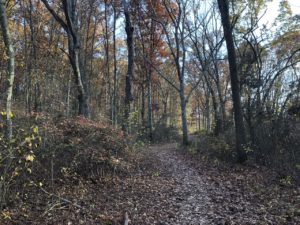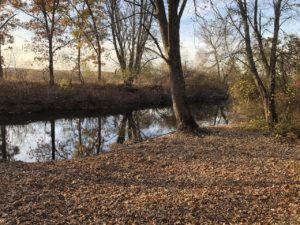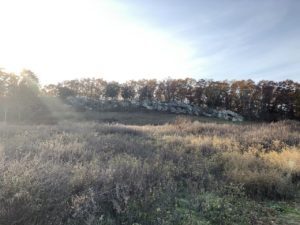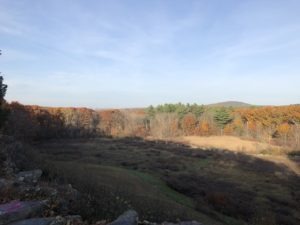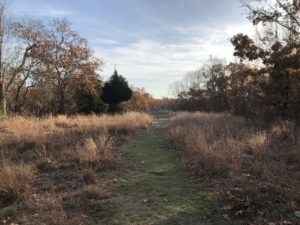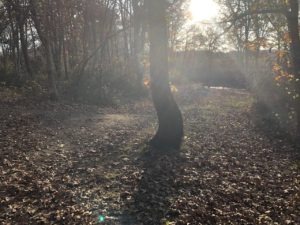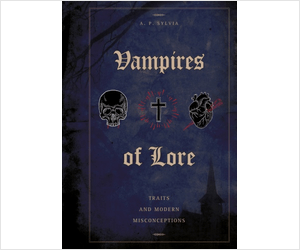In 1770, residents of Canton, MA, were terrorized by a ghostly wailing that emanated from deep within the forest of an area then known as Packeen. Many townsfolk heard the otherworldly voice and were at a loss as to what to do. They eventually turned to the local deacon in hopes that he could banish the terrifying Packeen ghost.
Below is an account of the incident from the History of the Town of Canton, published in 1893.
From the deep recesses of the forest which lay between the Packeen road and the Fowl meadows there was heard by the residents of that part of the town, about the year 1770, the sound of a voice, human, but at the same time so weird and melancholy in its tone that it sent a chill of horror through the listener. Henry Crane, Preserved Lyon, Joseph Aspinwall, – all described it as something between the wail of a woman and the cry of a catamount. Edward Downes and John Taunt and William Crane, 2d, spoke of it as the voice of a lost soul crying in the wilderness. Months rolled on, and still the sound proceeded from the watery marshes or the adjoining upland. Isaac Billings never pulled his boat across the ferry at the call of some belated traveller but what this unearthly sound caused him to ply his oars with redoubled vigor. What was to be done no one knew. Finally it was suggested that Deacon Elihu Crane could exorcise or dispel the troublesome Packeen ghost. The deacon was applied to, and after much persuasion and diligent prayer betook himself at midnight and alone to a lonesome and unfrequented part of the woods where his ghostship was supposed to make his headquarters. The deacon had a wonderfully powerful voice, and he poured it forth, so that the residents of Tiot or Clapboardtrees could have heard it had they been out that night. ‘I know,’ said he, ‘O unknown one, that thou art neither flesh and blood nor mortal in any way or shape. I pray thee no longer leave the pale realms of shade to haunt the regions of this earth. Leave, then, the Fowl meadows, and return to the place whence thou comest.’ This was sufficient. It is needless to say there was no more trouble from the Packeen ghost.
I find it quite interesting that so many residents of the area heard this mysterious wailing and that it lasted for so long. The sound is compared to a woman and a catamount (cougar), yet it possessed some strange quality that instilled fear in those who heard it. One naturally wonders if it was some kind of animal or natural phenomenon. However, if that were the case, it’s then surprising that the deacon’s efforts were immediately successful. It’s also important to note that my excerpt here was written over 100 years after the original incident, so it’s certainly possible that the story shifted over time. Regardless, it’s a fantastic tale.
In 1770, the location where this incident took place was actually part of Stoughton, MA. The town of Canton would incorporate 27 years later. The specific area known as Packeen no longer bears that name today. Based on what I’ve read, it would seem that Packeen roughly stretched from the modern day Canton Corner Historic District in the east to Signal Hill in the west. The Packeen Road referenced in the tale is gone, but a part of it was at the southern end of today’s Elm Street. Easier to identify is the Fowl Meadow, which is clearly marked on old maps and still exists today. It is a wetland area around the Neponset River. Based upon all this, it’s possible the wailing came from somewhere west of Elm Street and east of the Neponset River. Beyond that, it’s hard to pinpoint where exactly Deacon Crane performed his forceful exorcism.
For my visit to what was once Packeen, I decided to go to Signal Hill, which may be slightly southwest of where the wailing occurred. It is a 150-acre preserve that’s open to the public and features a hiking trail, access to the Neponset River, and parking. The hill itself is 188 feet tall and provides fantastic views of the surrounding area (including the Blue Hills, Boston, and the rest of what was once Packeen). Walking through the woods, one wonders if the deacon performed his ritual in a similar spot. Could the ferry in the tale have been situated not far from this point in the river?
It’s hard to say what the Packeen ghost was. Perhaps it was a person or a wild animal, or maybe the residents were correct and it was something supernatural. Regardless, it’s a fascinating account and Signal Hill is a great place to enjoy the outdoors.
Location
Signal Hill
University Road
Canton, MA 02021
Official site: https://thetrustees.org/place/signal-hill/
As you head south on University Road, you’ll see a sign for Signal Hill on your right. It’s before the last two buildings and the end of the road. As of writing this, access to the site is free.
Sources
“Canton, Atlas: Norfolk County 1876, Massachusetts Historical Map.” Historic Map Works. http://www.historicmapworks.com/Map/US/47269/Canton/Norfolk+County+1876/Massachusetts/.
“Canton Ponkapoag Neighborhood Map,1831.” Canton Historical Society. http://www.canton.org/maps/1831b.htm.
Comeau, George T. “True Tales from Canton’s Past: Packeen Ghost.” Canton Citizen. October 31, 2013. https://www.thecantoncitizen.com/2013/10/31/true-tales-from-cantons-past-packeen-ghost/.
“Fowl Meadow.” Neponset River Watershed Association. https://www.neponset.org/archived-pages/fowl-meadow/.
Huntoon, Daniel Thomas Vose. History of the Town of Canton. United States: J. Wilson and son, 1893. https://www.google.com/books/edition/History_of_the_Town_of_Canton/iSxNAAAAYAAJ.
Huntoon, Daniel Thomas Vose. Report of the Committee on Town Seal, and Report of the Committee on Naming the Streets of Canton. United States: William Bense, 1881. https://www.google.com/books/edition/_/hfhYAAAAMAAJ.
“Signal Hill.” The Trustees of the Reservations. https://thetrustees.org/place/signal-hill/.
Written by A. P. Sylvia

